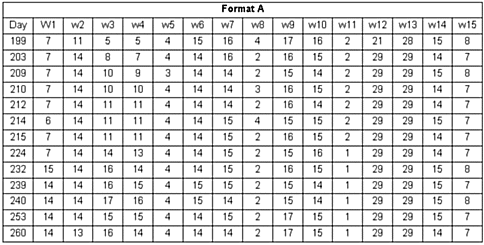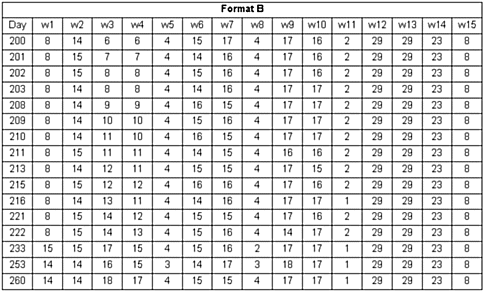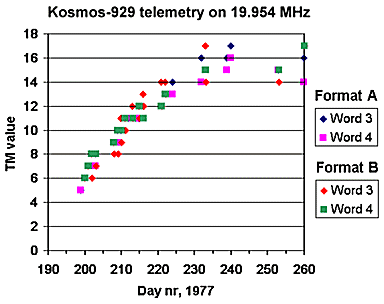![]()
![]()
During the frame duration
of 16 seconds sixteen equal word-length intervals are available. Fifteen
of these are used to transmit data, whilst the other, word zero contains
a synchronization pulse-train. The FSK transmitter is switched between
two radio frequencies, fH and fL, 1 kHz apart. (Listen
to Kosmos-929 here). At the beginning
of a data-word interval, fH is turned on. At some time before
the end of the interval, fH is turned off and fL
simultaneously turned on, and remains on until the end of the interval.
The ratio of the duration of fH to fH+fL
is a measure of the data value being transmitted. There are 32 possible
times within a word within a word when the fH to fL
transition can occur (2). The analogue data being
sampled has been quantised in one of 32 possible levels. The permissible
fH to fL transition times are defined in the synchronization
pulse-train which normally contains 29 pulses. In this text word-values
will be expressed in the form of integers ranging from 1 to 32, where 16
corresponds to fH being on for 50% of the word interval.
 |
 |
 Two
separate telemetry modes were transmitted on a time-sharing basis. Mode
A had a 30-pulse synchronization train and word 14 taking on the word value
15. Mode B was characterized by having 29 pulses in the synchronization
train and word 14 had the word value 23 (1).
One telemetry mode was transmitted for 30 minutes and the other for 30
minutes and then the cycle was repeated.
Two
separate telemetry modes were transmitted on a time-sharing basis. Mode
A had a 30-pulse synchronization train and word 14 taking on the word value
15. Mode B was characterized by having 29 pulses in the synchronization
train and word 14 had the word value 23 (1).
One telemetry mode was transmitted for 30 minutes and the other for 30
minutes and then the cycle was repeated.
Mode changes occurred at 28 min 55 sec and 58 min 55 sec past the hour. The commutators in the two modes were not synchronized anthe switch-over between modes could occur at any word within the frame. Although not synchronised, the cycling-rates of the two formats were equal to within +/- 20 milliseconds.
Different transmitter frequencies were employed for modes A and B. In mode A, fH=19.954 MHz and fL=19.953 MHz. For mode B, fH=19.955 MHz and fL=19.954 MHz.
In general, the transmited data words in modes A and B were quite similar. The tables above show word-values up to 17 September 1977. Word 3 and 4 in both modes were those that varied most during the first two months of the flight. In the graph on the right values of words 3 and 4 in both modes are plotted as a function of time.
It is still a mystery what
these two slowly varying values (3 and 4) signified. Similarly it is still
unknown why there were two different, but quite similar, telemetry modes.
Did they represent two redundant chains of subsystems?
| Word | 1 | 2 | 3 | 4 | 5 | 6 | 7 | 8 | 9 | 10 | 11 | 12 | 13 | 14 | 15 |
| Mode A | 14 | 14 | 17 | 16 | 18 | 14 | 6 | 22 | 6 | 6 | 17 | 30 | 23 | 21 | 14 |
| Mode B | 14 | 14 | 2 | 2 | 2 | 14 | 6 | 23 | 7 | 7 | 17 | 30 | 22 | 22 | 15 |
Otherwise there were negligible changes in word values between modes. However, word 11 varied much - between 15 and 27, but there was no systematic variation over time. Word 8 was always at 22-23 except during the orbit when the craft docked with Salyut-6. Then and only then did word 8 drop to 14.
19.942 MHz
During this flight a second
short-wave frequency was also observed, 19.942 MHz. Signals on this frequency
were not continuous but rather quite rare. It was discovered by Jan-Ola
Dahlberg in Malmö in southern Sweden. Several stations, including
myself, confirmed the signal. It was not picked up after 11 May 1981. I
have called this signal mode C. To compare with modes A and B I have repeated
the table above with mode C included. One can then see that modes C contained
many more short words than the two other modes. It had 29 pulses in the
synchronization train.
| Word | 1 | 2 | 3 | 4 | 5 | 6 | 7 | 8 | 9 | 10 | 11 | 12 | 13 | 14 | 15 |
| Mode A | 14 | 14 | 17 | 16 | 18 | 14 | 6 | 22 | 6 | 6 | 17 | 30 | 23 | 21 | 14 |
| Mode B | 14 | 14 | 2 | 2 | 2 | 14 | 6 | 23 | 7 | 7 | 17 | 30 | 22 | 22 | 15 |
| Mode C | 2 | 20 | 2 | 2 | 2 | 2 | 2 | 2 | 2 | 2 | 29 | 2 | 6 | 21 | 2 |
Jan-Ola Dahlberg also reported
that on 6 August, 1977, he heard a signal near 19.942 MHz while listening
to Kosmos-929 on 19.954 MHz. The word values of the signal near 19.942
MHz were similar to those from Kosmos-1267 on this frequency. Perhaps Kosmos-929
also used this frequency. The short words sounded like "blips", so Geoff
Perry initially called the three modes the "no blip", "three blip" and
"eight blip" mode! In this way they were easily identifiable by simply
listening with the "naked ear"!
| Word | 1 | 2 | 3 | 4 | 5 | 6 | 7 | 8 | 9 | 10 | 11 | 12 | 13 | 14 | 15 |
| Kosmos-1443 | 14 | 14 | 2 | 2 | 2 | 14 | 30 | 23 | 7 | 7 | 17 | 30 | 23 | 22 | 15 |
| Kosmos-1267, Mode B | 14 | 14 | 2 | 2 | 2 | 14 | 6 | 23 | 7 | 7 | 17 | 30 | 22 | 22 | 15 |
| Word | 1 | 2 | 3 | 4 | 5 | 6 | 7 | 8 | 9 | 10 | 11 | 12 | 13 | 14 | 15 |
| Value | 22 | 22 | 2 | 1 | 2 | 21 | 15 | 22 | 7 | 7 | 20 | 29 | 22 | 22 | 15 |